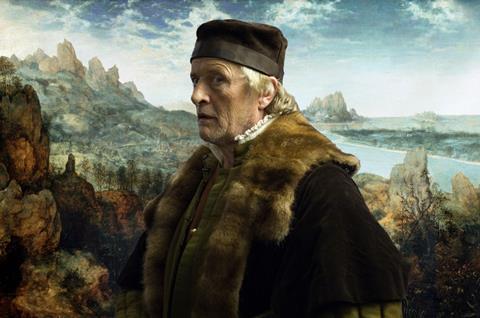Dir: Lech Majewski. Poland/Sweden. 2010. 92mins

Pieter Bruegel the Elder’s 1564 painting of the crucifixion comes to the screen in Lech Majewski’sTHE MILL & THE CROSS. The epic film - screening in the New Frontier section of Sundance - is a breakthrough in transforming a painting into a moving picture, but sadly the drama doesn’t rise to the level of its novelty and ambition.
The tech-savvy will still marvel at the film’s combination of blue-screen, live-action shot in the actual landscapes found in Breugel’s paintings and a vast backdrop painted by Majewski himself.
THE MILL & THE CROSS will screen initially as an event at film festivals and museums around the world. Breugel’s stature as an artist ensures global interest, but the film’s theatrical future will probably be built on single events rather than theatrical bookings. Its novelty guarantees the film a long shelf life, assuming that no one will try anything comparable on such a scale.
Majewski’s experiment is based on The Way to Calvary, Breugel’s depiction of the procession to the place of Christ’s martyrdom through a landscape in which a range of other activities reminds viewers that life goes on nonetheless.
The painting and Majewski’s project situate the scene in Flanders of the 1560s, when Spanish rulers executed heretics in a brutal occupation, crucifying men and buying women alive.
Majewski recreates the painting as an ensemble of scenes, distributing figures in the vast landscape. Costumes are vivid and the detail brings the breadth of Breugel’s vision to life. Close-ups resemble Renaissance portraits. On the technical level, the film is a revelation, on a grander scale than Peter Greenaway or Peter Webber (Girl with a Pearl Earring).
Sections of the painting become scenes in Majewski’s film, as red-suited soldiers on horseback enforce Spanish dominion and Bruegel (Rutger Hauer) discusses his preparatory drawings for depicting a “web” of human activity.
Majewsi forces you to view the panting afresh, yet acting in his scenes varies from realism and the gestural motions of Breugel’s figures. For all his painstaking work, Majewski’s drama rarely rises above the level of reenactment. (One exception is the killing of man whose body is left for crows to eat.)
The tech-savvy will still marvel at the film’s combination of blue-screen, live-action shot in the actual landscapes found in Breugel’s paintings and a vast backdrop painted by Majewski himself. This is not a modest project on any level.
As Bruegel (who died in 1569 at 44), Hauer, now 67, plays the role as a master painter who assembles vast human scenes. Hauer’s observations are subdued, yet Michael York is more imposing as a banker and collector who watches the rape of his country. As Mary, Charlotte Rampling is just as mournful.
Majewski has been making films about art and artists since his collaboration on Basquiat (1996) with Julian Schnabel. Yet is ultimatelyTHE MILL & THE CROSS is a personal film, linking Breugel’s evocation of the Passion to his passion for persecuted Flanders.
Majewski is not Mel Gibson. His film is rooted in admiration, not worship. In his admiration for Bruegel, there is a recognition of greatness that won’t be outdone by cinema, and it isn’t. But this is an experiment that should not be missed.
Production companies: Polish Film Institute, Telewisja Polska, Bokomotiv Filmproduktion, Odeon Studio, Silesia Film, 24 Media, Supra Film, Arkana Studio, Piramida Film
International Sales: WIDE Management, www.widemanagement.com
Executive Producer: Angelus Silesius
Co-Producer: Freddy Olsson
Screenplay: Michael Francis Gibson, Lech Majewski
Cinematography: Lech Majewski, Adam Sikora
Production designers: Katarzyna Sobanska, Marcel Slawinski
Main Cast: Rutger Hauer, Michael York, Charlotte Rampling, Joanna Litwin, Dorota Lis






![The Brightest SunScreen[Courtesy HKIFF]](https://d1nslcd7m2225b.cloudfront.net/Pictures/274x183/3/5/0/1448350_thebrightestsunscreencourtesyhkiff_312678.jpg)














